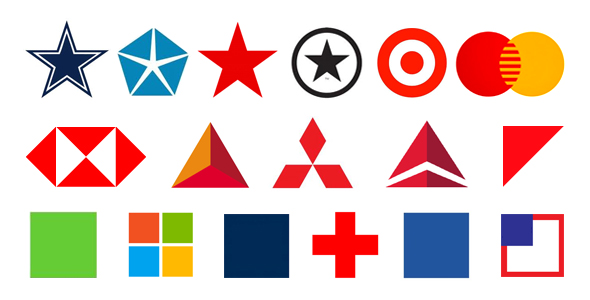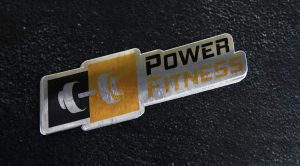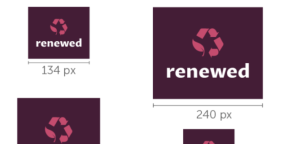Have you ever wondered why certain logos make you feel a certain way? The shapes used in logo design play a crucial role in shaping our perceptions and emotions towards a brand. From the simplicity of a circle to the sharpness of a triangle, each shape has a unique symbolism that can be leveraged to create a powerful logo design.
Understanding the psychology of shapes is essential for any designer looking to create a logo that resonates with their target audience. For example, circular logos are often associated with unity, harmony, and community, making them a popular choice for brands that want to convey a sense of togetherness. On the other hand, angular shapes like triangles and squares can evoke feelings of stability, strength, and efficiency, making them ideal for brands in the tech industry.
In this article, we will explore the meaning of different shapes in logo design and how they can be used to create a powerful visual identity for your brand. Whether you’re a designer looking to improve your logo design skills or a business owner looking to create a memorable brand identity, this guide will provide you with the knowledge and inspiration you need to create a logo that stands out from the crowd.
The Power of Shape Symbolism
When it comes to logo design, shapes play a crucial role in conveying meaning and message. Different shapes have different symbolic meanings that can evoke emotions and influence perception. Understanding the psychology of shapes is essential for creating a logo that resonates with your target audience and communicates your brand values effectively.
Here are some of the most common shapes used in logo design and their symbolic meanings:
Circles
Circles are one of the most versatile shapes used in logo design. They represent unity, wholeness, and eternity. Circles are often used to convey a sense of community, connection, and perfection. They are also associated with the sun, the moon, and the universe, making them ideal for brands that want to convey a sense of global appeal.
Triangles
Triangles are dynamic and powerful shapes that can evoke a range of emotions, depending on their orientation and size. An upward-pointing triangle represents growth, stability, and progress, while a downward-pointing triangle represents stability, foundation, and strength. Triangles are often used in technology and finance logos to convey innovation and stability.
Squares and Rectangles
Squares and rectangles are stable and balanced shapes that represent order, structure, and reliability. They are often used in construction, real estate, and finance logos to convey stability and trustworthiness. Squares and rectangles can also be used to convey a sense of simplicity and minimalism.
Organic Shapes
Organic shapes are free-flowing and irregular shapes that are often found in nature. They represent creativity, spontaneity, and playfulness. Organic shapes are often used in food and beverage logos to convey a sense of freshness and naturalness.
Abstract Shapes
Abstract shapes are shapes that do not have a clear reference to real-world objects. They are often used to convey a sense of creativity, innovation, and uniqueness. Abstract shapes can be used in a wide range of industries, from technology to fashion, to convey a sense of originality and differentiation.
In summary, the shape of a logo is a powerful tool for conveying meaning and emotion. Each shape has its own symbolic meaning that can influence how people perceive your brand. By understanding the psychology of shapes, you can create a logo that resonates with your audience and communicates your brand values effectively.
Understanding Logo Design
When it comes to branding, a logo is one of the most important elements. It’s the visual representation of your company and can help create a lasting impression on potential customers. But what makes a good logo? And how can you use shapes to convey your brand’s message?
A logo is more than just a simple image. It’s a carefully crafted design that should reflect your company’s values and personality. It’s important to consider the unique identity of your business and what you want your logo to represent.
One way to do this is by choosing shapes that align with your brand’s message. Different shapes can convey different meanings and emotions. For example, a circle can represent unity and wholeness, while a triangle can symbolize strength and stability.
When designing your logo, consider the following:
- What shapes align with your brand’s values and personality?
- How can you use these shapes to create a unique and memorable logo?
- What emotions do you want your logo to evoke in potential customers?
It’s also important to consider the color scheme of your logo. Different colors can have a significant impact on how your logo is perceived. For example, blue can represent trust and reliability, while red can symbolize passion and energy.
In conclusion, a logo is a crucial element of your brand identity. By carefully considering the shapes and colors used in your logo design, you can create a powerful visual representation of your company that resonates with potential customers.
Shapes in Logo Design
When it comes to designing a logo, the shape you choose can have a significant impact on your brand’s message and how it is perceived by your audience. Different shapes have different meanings and associations, which can influence the emotions and thoughts that people have when they see your logo.
Circle
The circle is a classic shape that is often used in logo design. It represents unity, wholeness, and completeness. Circles can also convey a sense of community, connection, and friendship. If you’re looking to create a logo that feels welcoming and inclusive, a circle might be a good choice.
Square
Squares are another popular shape in logo design. They represent stability, balance, and order. Squares can also convey a sense of professionalism and reliability. If you want your logo to communicate a sense of trustworthiness and dependability, a square might be a good option.
Triangle
Triangles are a more dynamic and energetic shape that can convey a sense of movement and progress. They can also represent strength, power, and stability. Depending on the orientation of the triangle, it can convey different meanings. An upward-facing triangle can represent growth and aspiration, while a downward-facing triangle can represent stability and foundation.
When choosing a shape for your logo, it’s important to consider the message you want to convey and the emotions you want to evoke. Keep in mind that different shapes can have different cultural and historical associations, so it’s important to do your research and make sure that the shape you choose aligns with your brand’s values and target audience.
In addition to the shape itself, you can also use color, typography, and other design elements to further reinforce the message and personality of your brand. By carefully considering the shape and other design elements of your logo, you can create a powerful visual identity that resonates with your audience and helps you stand out in a crowded market.
Color and Shape: A Dynamic Duo
When it comes to logo design, color and shape are two of the most important elements to consider. The combination of both can create a powerful and memorable visual identity for your brand. Here’s why:
Color Psychology
Colors have a powerful effect on our emotions and can even influence our behavior. In logo design, it’s essential to choose colors that align with your brand’s personality and values. For example, blue is often associated with trust and professionalism, while green represents growth and nature.
Using color psychology in combination with shape symbolism can create an even stronger impact. For instance, a circular logo with blue and green colors can convey a sense of trust and growth, making it a perfect fit for a financial or investment company.
Shape Symbolism
Shapes can also have a significant impact on the message your logo conveys. Different shapes can evoke different emotions and associations. For example, circles are often associated with unity and wholeness, while triangles can represent strength and stability.
When combined with color psychology, shape symbolism can create a powerful visual identity for your brand. For instance, a square logo with bold and vibrant colors can convey a sense of stability and strength, making it a perfect fit for a construction or engineering company.
In conclusion, color and shape are two of the most important elements to consider when designing a logo. By using color psychology and shape symbolism in combination, you can create a dynamic and memorable visual identity that aligns with your brand’s personality and values.
Psychology of Shape Symbolism
When it comes to logo design, the shapes used can have a significant impact on how people perceive your brand. Understanding the psychology of shape symbolism can help you choose the right shapes to communicate your brand’s message effectively.
Symmetrical/Geometric Shapes
Symmetrical and geometric shapes are associated with organization, stability, and order. These shapes are often used by businesses that want to convey a sense of professionalism and reliability. For example, the Audi logo features four interlocking rings, which represent the merger of four car manufacturers. The symmetrical design of the rings communicates the company’s stability and strength.
Organic Shapes
Organic shapes are associated with pleasure, comfort, interest, and spontaneity. These shapes are often used by businesses that want to convey a sense of creativity and innovation. For example, the Whole Foods logo features a green leaf, which represents the company’s commitment to natural and organic products. The organic shape of the leaf communicates the company’s focus on living a healthy and sustainable lifestyle.
Abstract Shapes
Abstract shapes are associated with literal interpretations of ideas or directions. These shapes can be used to communicate a wide range of messages, depending on the context. For example, the Apple logo features a simple apple shape, which represents the company’s focus on simplicity and innovation. The abstract shape of the apple communicates the company’s commitment to creating products that are easy to use and understand.
Vertical and Horizontal Logos
The orientation of a logo can also have an impact on how people perceive your brand. Vertical logos are associated with strength, power, and authority, while horizontal logos are associated with stability and balance. For example, the Coca-Cola logo is a horizontal design, which communicates the company’s focus on tradition and stability.
Spiral Logos
Spiral logos are associated with growth, evolution, and change. These logos can be used to communicate a sense of forward momentum and progress. For example, the BP logo features a green and yellow sunflower design, which represents the company’s commitment to renewable energy and sustainable practices. The spiral shape of the petals communicates the company’s focus on growth and innovation.
Understanding the psychology of shape symbolism can help you choose the right shapes to communicate your brand’s message effectively. By selecting shapes that align with your brand’s values and goals, you can create a logo that resonates with your target audience and helps you stand out in a crowded marketplace.
Influence of Shape Symbolism on Brand Perception
The shape of a logo can have a significant impact on how consumers perceive a brand. Shapes can evoke emotions and associations in consumers that influence their purchasing decisions. Therefore, it’s crucial to choose the right shape for your logo to create a positive brand perception and connect with your target audience.
Shapes can be divided into three major categories: geometric, abstract/symbolic, and organic. Each category has its own set of associations and emotions that it evokes in consumers. Geometric shapes, such as squares, triangles, and circles, are often associated with stability, strength, and balance. They are commonly used in logos for finance, technology, and engineering companies.
Abstract/symbolic shapes, such as arrows, stars, and hearts, are more open to interpretation. They can evoke a wide range of emotions and associations depending on the context and cultural background of the consumer. For example, an arrow can symbolize movement and progress, while a star can represent excellence and achievement.
Organic shapes, such as curves and spirals, are associated with nature, growth, and creativity. They are often used in logos for beauty, wellness, and art-related businesses. Organic shapes can create a sense of warmth and approachability, making them ideal for brands that want to connect with their audience on a more personal level.
In addition to the shape itself, the color and font used in the logo can also influence brand perception. For example, the color red can evoke feelings of passion and excitement, while blue can create a sense of trust and reliability. The font used in the logo can also convey a brand’s personality, with bold and modern fonts representing a more edgy and innovative brand, while serif fonts can create a more classic and sophisticated feel.
In conclusion, the shape of a logo plays a crucial role in creating a strong brand perception and connecting with your target audience. By choosing the right shape, color, and font, you can create a logo that effectively communicates your brand’s values and personality.
Case Studies of Shape Symbolism in Logo Design
When it comes to logo design, the use of shapes can play a significant role in creating a brand identity that resonates with consumers. In this section, we will explore some case studies of shape symbolism in logo design for well-known brands.
Apple
Apple’s logo is a simple yet iconic design that has become synonymous with the brand. The logo features a bitten apple, with a clean and minimalist design that has remained consistent over the years. The use of the apple shape in the logo is significant, as it represents knowledge, innovation, and creativity. The bite out of the apple also adds a playful and approachable element to the design.
Nike
The Nike Swoosh is one of the most recognizable logos in the world. The Swoosh is a simple, curved line that represents movement and speed. The shape of the Swoosh is significant, as it creates a sense of motion and energy that is perfectly aligned with the brand’s values. The Swoosh is also a versatile shape that can be used in a variety of ways, making it an ideal choice for a logo.
McDonald’s
McDonald’s is another brand that has a highly recognizable logo. The logo features two golden arches that form an M shape. The arches are significant, as they represent the brand’s values of consistency, reliability, and familiarity. The M shape is also a versatile design element that can be used in a variety of ways, such as in advertising and packaging.
In conclusion, the use of shapes in logo design can be a powerful tool for creating a brand identity that resonates with consumers. By choosing shapes that align with the brand’s values and messaging, designers can create logos that are memorable, recognizable, and effective.
Future Trends in Shape Symbolism and Logo Design
As the world of design continues to evolve, so do the trends in shape symbolism and logo design. Here are some exciting future trends to look out for:
1. Minimalism with a Twist
Minimalistic logos have been popular for some time now, but in the future, we can expect to see a twist on this trend. Instead of just simple shapes and fonts, designers will incorporate unique and unexpected elements to create logos that are both minimalistic and memorable.
2. Playful Shapes
In the past, logos were often designed to convey a sense of professionalism and seriousness. However, in the future, we can expect to see more playful shapes and designs. This trend is perfect for brands that want to appeal to a younger audience or convey a sense of fun and creativity.
3. Geometric Shapes
Geometric shapes have always been popular in logo design, but in the future, we can expect to see even more creative uses of these shapes. From complex geometric patterns to simple shapes with bold colors, designers will continue to push the boundaries of what can be done with geometric shapes.
4. Hand-Drawn Logos
Hand-drawn logos have a unique charm and authenticity that is hard to replicate with digital design tools. In the future, we can expect to see more brands embracing this trend and opting for hand-drawn logos that convey a sense of personality and individuality.
5. Dynamic Logos
Dynamic logos are logos that change over time or in response to different stimuli. These logos are perfect for brands that want to convey a sense of innovation and adaptability. In the future, we can expect to see more brands embracing this trend and creating logos that are not only visually appealing but also functional and interactive.
Overall, the future of shape symbolism and logo design is exciting and full of possibilities. Whether you’re a designer or a business owner, it’s important to stay up-to-date with these trends to ensure that your brand remains relevant and memorable.
Conclusion
Congratulations! You have learned about the power of shape symbolism in logo design. By understanding the meanings and associations of different shapes, you can create a logo that effectively communicates your brand’s personality and values to your target audience.
When designing your logo, keep in mind that certain shapes are associated with specific emotions and concepts. For example, circles represent unity and wholeness, while triangles symbolize stability and balance. By choosing the right shape for your logo, you can evoke the desired emotional response from your audience.
Remember that your logo is a visual representation of your brand, so it’s important to choose a shape that accurately reflects your business’s values and personality. Take the time to survey your customers and consider their feedback when designing your logo.
In addition to shape symbolism, other design elements such as color, font, and iconography can also convey meaning and emotion in your logo. Experiment with different combinations of these elements to find the perfect balance that accurately represents your brand.
By creating a logo that effectively communicates your brand’s personality and values, you can establish a strong visual identity that sets you apart from your competitors and resonates with your target audience. Good luck and happy designing!
Barry Edwards is a digital marketing expert with a deep understanding of content strategy, logo, and branding principles. Holding a Bachelor’s degree in Marketing from Beaconhill College, he offers valuable insights on digital marketing trends and strategies through his writing. Follow Barry’s work to stay updated on the latest in online marketing and branding.



